NCERT Solutions for Chapter 11 Class 6 Science: Nature’s Treasures - FREE PDF Download
NCERT Solutions for Class 6 Science Chapter 11 Nature’s Treasures helps students explore the various natural resources around them and understand their significance. This chapter discusses how resources like water, air, and minerals play a vital role in our daily lives. Vedantu provides simple and clear explanations for each topic, ensuring students grasp the key concepts effectively. Class 6 Science NCERT Solutions offer detailed answers to all questions, helping in exam preparation and improving understanding.
 Table of Content
Table of ContentDownload the FREE PDF for Class 6 Science Chapter 11 Question Answers, prepared by Vedantu experts and aligned with the latest CBSE Class 6 Science Syllabus, to make learning more engaging and productive.
Glance on Class 6 Science Chapter 11 Nature’s Treasures
In this chapter, "Nature’s Treasures," students learn about the variety of natural resources our planet provides.
It introduces different types of resources such as water, air, minerals, and forests.
Class 6 Science Chapter 11 emphasises the need to conserve these resources to ensure their availability for future generations.
Chapter 11 Nature’s Treasures discusses how natural resources are used in daily life and their impact on the environment.
The chapter helps to build awareness about the value of nature's resources and the importance of preserving them.
It includes engaging explanations, illustrations, and questions to help students understand and retain key concepts.
Access NCERT Solutions for Class 6 Science Chapter 11 Nature’s Treasures
LET US ENHANCE OUR LEARNING
1. Fig. 11.9 shows items related to natural resources. Match them with their jumbled-up names. Make another table and write the names of these resources. Classify these resources as renewable or non-renewable.
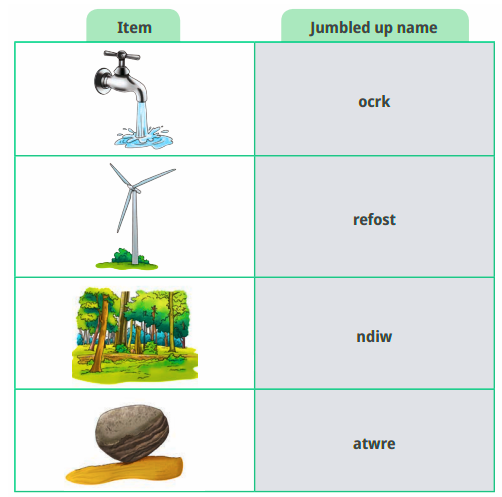
Ans:
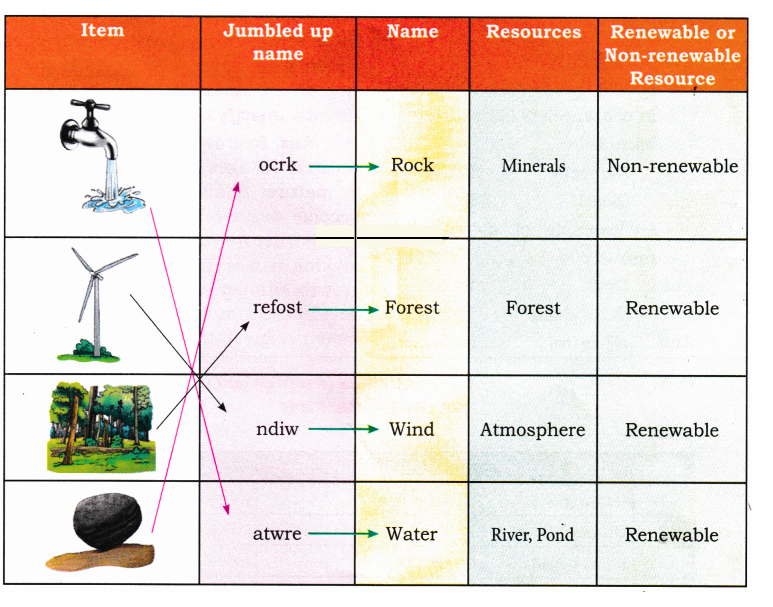
2. State whether the following statements are True [T] or False [F]. If False, correct them.
(i) Nature has all the resources to meet human needs. [ ]
(ii) Machines are a resource found in nature. [ ]
(iii) Natural gas is a non-renewable resource. [ ]
(iv) Air is a renewable resource. [ ]
Ans: (i) Nature has all the resources to meet human needs. [F]
Explanation: Nature does not have all the resources to meet human needs. Some resources are limited and need to be managed carefully.
(ii) Machines are a resource found in nature. [F]
Explanation Machines are not found in nature; they are human-made resources.
(iii) Natural gas is a non-renewable resource. [T]
Explanation: This statement is true. Natural gas is a non-renewable resource because it cannot be replenished quickly.
(iv) Air is a renewable resource. [T]
Explanation: This statement is true. Air is considered a renewable resource as it is constantly being replenished through natural processes.
3. Fill in the blanks using the most appropriate option—
(i) A fuel that is commonly used in two-wheelers like scooters or bikes is.........
(a) Kerosene
(b) Petrol
(c) Diesel
(d) LPG
Ans: A fuel that is commonly used in two-wheelers like scooters or bikes is (b) Petrol.
(ii) An example of a renewable resource is ..................
(a) Coal
(b) Water
(c) Natural gas
(d) Petrol
Ans: An example of a renewable resource is (b) Water.
4. Classify the following as renewable or non-renewable resources—coal, natural gas, forests, and minerals.
Ans:
Coal: Non-renewable
Natural Gas: Non-renewable
Forests: Renewable
Minerals: Non-renewable
5. Why do we say that petroleum is a non-renewable resource?
Ans: Petroleum is considered a non-renewable resource because it forms very slowly over millions of years from the remains of ancient marine organisms. Once extracted and used, it cannot be replenished within a human timeframe. The rate of consumption far exceeds the rate at which new deposits are formed, making it finite and unsustainable in the long term.
6. It is difficult to regrow forests. Justify this statement.
Ans: Regrowing forests is difficult due to:
Time: Forests require many years to mature. The growth process is slow, and it takes decades or even centuries for a forest to reach its full potential.
Complex Ecosystem: Forests are complex ecosystems with diverse plant and animal species. Restoring the full biodiversity of a forest is challenging and requires careful management.
Soil and Climate: Degraded land may have poor soil quality or unfavourable climatic conditions that hinder the growth of new trees and forest regeneration.
7. Make a list of five daily activities in which you use natural resources. Suggest ways by which you can reduce their use.
Ans:
Driving a Car (Uses petrol/diesel)
Reduce Use: Carpool, use public transport, bike, or walk.
Using Electricity (Generated from coal, natural gas, or other resources)
Reduce Use: Turn off lights and electronics when not in use, use energy-efficient appliances, and consider renewable energy sources.
Drinking Water (From natural sources)
Reduce Use: Use water-saving fixtures, fix leaks, and practise water conservation techniques like shorter showers and full loads in dishwashers and washing machines.
Cooking Food (Uses gas or electricity)
Reduce Use: Cook in batches, use energy-efficient appliances, and make use of leftover food.
Washing Clothes (Uses water and electricity)
Reduce Use: Wash clothes in full loads, use cold water when possible, and air-dry clothes instead of using a dryer.
8. List four activities that are possible due to the presence of air.
Ans:
Breathing: Essential for the survival of humans and animals.
Flight: Air allows birds, aeroplanes, and other flying objects to move through the sky.
Wind Energy Generation: Wind turbines harness the movement of air to generate electricity.
Pollination: Air currents help in the distribution of pollen from one flower to another, facilitating plant reproduction.
9. How can you contribute towards enhancing the green cover of your locality? Make a list of actions to be taken.
Ans:
Plant Trees: Participate in or organise tree-planting drives in your community.
Support Local Green Initiatives: Join local environmental groups or support community green projects.
Maintain Gardens: Grow and maintain plants in your garden or community green spaces.
Educate Others: Raise awareness about the importance of trees and green spaces.
Avoid Deforestation: Advocate against deforestation and support sustainable land use practices.
In the given illustration, we see that food is being cooked. Answer the following questions—
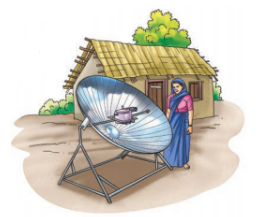
(i) What type of energy is being used for cooking?
Ans: The energy being used for cooking in the image is solar energy, which is harnessed from sunlight.
(ii) Name one benefit and one drawback of using this type of energy for cooking.
Ans:
Benefit: Solar energy is a renewable and environmentally friendly source of energy. It does not emit any harmful gases or pollutants during cooking.
Drawback: Solar cooking is dependent on sunlight, so it cannot be used at night or on cloudy days, which limits its availability and consistency.
11. Cutting down trees on a large scale impacts the quality of the soil. Why do you think it is so?
Ans: Cutting down trees, or deforestation, leads to soil degradation because trees help prevent soil erosion. Their roots bind the soil, keeping it in place, and the canopy reduces the impact of rain on the soil surface. Without trees, the soil becomes loose and is easily washed away by rain, reducing its fertility and making it prone to erosion.
12. Explain two ways in which human activities pollute the air. Propose one action that can help in reducing air pollution.
Ans:
Burning fossil fuels: Vehicles, factories, and power plants burn fossil fuels like coal, oil, and gas, releasing harmful gases like carbon dioxide (CO₂), sulphur dioxide (SO₂), and nitrogen oxides (NOₓ) into the air, contributing to air pollution and climate change.
Industrial emissions: Factories release pollutants, including chemicals, smoke, and particulate matter, into the atmosphere, affecting air quality and human health.
Action to reduce air pollution: Encouraging the use of renewable energy sources, such as solar and wind power, can significantly reduce air pollution by minimising dependence on fossil fuels and reducing industrial emissions.
13. A family uses solar panels to generate electricity, a gas stove to cook food, and a windmill for pumping water from a well. What would happen if there were no sunlight for a week?
Ans: If there were no sunlight for a week, the solar panels would not generate electricity, leading to a power shortage for the family. They would need an alternative energy source, such as stored electricity or a backup generator, to fulfil their energy needs. The gas stove and windmill would not be affected by the lack of sunlight, so cooking food and pumping water could continue normally.
14. Fill up the blanks using the following terms— (fossil fuels, forest, air, petroleum, coal, water, and nonrenewable resource)
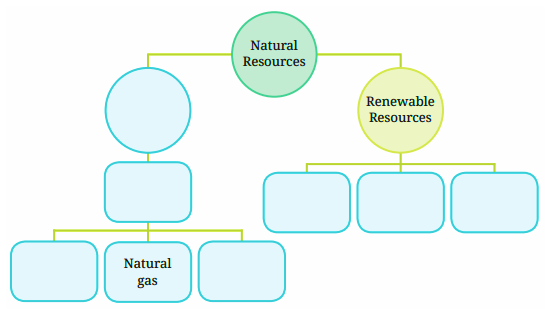
Ans:
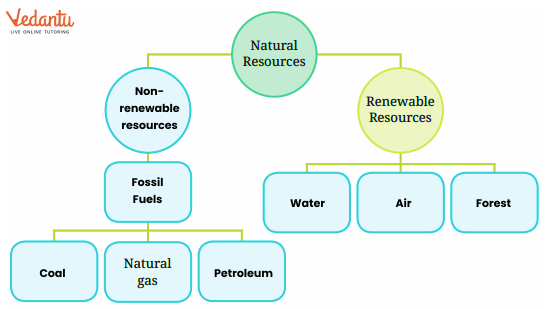
15. There is an increasing demand for trees to meet the requirements of industries and for housing. Therefore, trees are being felled. Is it justified? Discuss and prepare a brief report.
Ans: The increasing demand for trees due to industrial and housing development raises a significant environmental concern. Trees are essential for maintaining ecological balance, producing oxygen, absorbing carbon dioxide, and supporting biodiversity. However, the rapid pace at which trees are being felled is alarming and unsustainable. While industries and housing developments are necessary for economic growth and urbanisation, indiscriminate deforestation is not justified. It leads to environmental degradation, loss of wildlife habitats, and soil erosion, contributing to climate change.
A balance must be struck between development and conservation. Sustainable practices such as afforestation (planting new trees), using recycled materials, and incorporating eco-friendly building designs can help mitigate the impact of deforestation. Policies for responsible tree management and the promotion of green spaces in urban planning are also essential. Therefore, the felling of trees should only occur with effective reforestation strategies in place to preserve the environment for future generations.
16. Propose a plan to use less water in your school. What steps would you take to make this plan happen and how would it help the environment?
Ans:
Plan to Use Less Water in School
Objective: To reduce water usage in the school and promote water conservation, benefiting the environment by preserving this valuable resource.
Steps to Implement the Plan:
Install Water-Saving Devices: Equip all faucets, toilets, and urinals with low-flow devices to reduce water wastage.
Repair Leaks: Conduct regular checks for leaks in water pipes, faucets, and bathrooms, ensuring timely repairs to prevent water wastage.
Educate Students and Staff: Launch an awareness campaign about the importance of water conservation, teaching students and staff to use water mindfully, like turning off taps while washing hands or using minimal water during cleaning.
Rainwater Harvesting: Set up a rainwater harvesting system to collect and store rainwater, which can be used for gardening, cleaning, and other non-potable purposes.
Water-Efficient Landscaping: Replace water-intensive plants in the school garden with native, drought-resistant species, which require less watering.
Monitor Water Usage: Install water metres in key areas of the school to track water consumption and identify areas for further improvement.
How It Helps the Environment:
Reduces the depletion of freshwater resources.
Decreases the energy required for water treatment and distribution, lowering the school’s carbon footprint.
Prevents water wastage, ensuring more water is available for future use and reducing stress on local water bodies.
LEARNING FURTHER
Rainwater harvesting is an age-old practice in India. Find out some of the traditional rainwater harvesting techniques being used in your state or other parts of the country.
Ans: India has a rich history of traditional rainwater harvesting techniques that vary across different regions, based on local climatic conditions and terrain. Here are some traditional methods used in different parts of the country:
Kund (Rajasthan and Gujarat): Kunds are small circular underground structures used to collect rainwater in sandy, arid regions. They have a catchment area to collect and channel water into the kund, where it is stored for later use, especially during droughts.
Johads (Rajasthan): Johads are small earthen check dams built to collect rainwater. These help in recharging groundwater and are highly effective in areas with low rainfall.
Zing (Ladakh): Zings are small tanks that collect the melted water from glaciers. The water is diverted to fields through a network of channels, making agriculture possible in the cold, arid region.
Ahar-Pyne (Bihar): This traditional technique includes two structures: the Ahar, which is a reservoir, and the Pyne, a channel that distributes the water to agricultural fields. This method is commonly used for irrigation.
Bamboo Drip Irrigation (Meghalaya): This system involves using bamboo pipes to carry water from mountain streams to farmlands. It is an efficient way of collecting and transporting water in hilly areas.
Eri (Tamil Nadu): The Eri system is an ancient water management technique where tanks and lakes are constructed to store and manage rainwater for irrigation purposes. This also helps in recharging groundwater levels.
These traditional methods showcase how people in different parts of India have adapted to their environment and effectively managed rainwater harvesting for centuries.
Investigate the effect of air pollution on human health by interacting with your elders or community members and identify the main sources of air pollution in your local area. Based on your findings, suggest two practical steps that your school or community could take to help reduce air pollution.
Ans: Upon interacting with elders and community members, I discovered that air pollution significantly affects human health. The common health problems associated with air pollution include respiratory issues like asthma, bronchitis, and allergies, as well as cardiovascular diseases. Prolonged exposure to polluted air can lead to more severe health conditions, especially in children and the elderly.
Main Sources of Air Pollution in the Local Area:
Vehicle emissions from cars, buses, and trucks.
Industrial pollution from factories and manufacturing units.
Burning of garbage and agricultural waste.
Two Practical Steps to Reduce Air Pollution:
Encourage Carpooling and Cycling: Schools can promote carpooling among students and staff, and encourage cycling to reduce vehicular emissions. Setting up a "no car day" once a week could also help.
Planting Trees Around the School: Organising tree plantation drives in the community and school can help absorb pollutants like carbon dioxide and improve air quality.
Prepare a list of the names and uses of important minerals and rocks that are used in your village/town/city for various purposes.
Ans: Here is a list of important minerals and rocks used in my town/city:
Granite: Used in construction, particularly for building floors, countertops, and monuments due to its strength and durability.
Limestone: Commonly used in cement production, as well as in the construction of buildings and roads.
Marble: Popular for use in sculpting, construction of buildings, and decorative purposes, especially for flooring and tabletops.
Sandstone: Used in the construction of buildings, walls, and sometimes as decorative stones.
Quartz: Widely used in glass-making and also in electronics for its piezoelectric properties.
Gypsum: Used in making plaster of Paris and in the construction industry for drywall or plasterboards.
You are an eco-club monitor. Organise a tree plantation drive in your school with the help of your teacher. List the steps required for organising this activity. Prepare a one-page report listing the names of the trees planted along with their importance.
Ans:
Steps to Organise a Tree Plantation Drive:
Get Permission: Seek permission from the school administration to organise the event.
Involve Teachers and Students: Collaborate with teachers, students, and volunteers from different classes.
Choose a Location: Identify suitable areas within the school campus where trees can be planted.
Select the Trees: Choose tree species suitable for the local climate and environment. Ensure they are native trees that benefit the ecosystem.
Gather Materials: Arrange saplings, shovels, water, and compost or fertilisers.
Assign Roles: Distribute responsibilities, such as digging, planting, watering, and labelling the trees, among volunteers.
Educate: Provide information to participants about the importance of each tree and how to care for them.
Tree Plantation Drive Report
Date: 13/09/2024
Location: XYZ
As part of the school eco-club initiative, we successfully organised a tree plantation drive to contribute to the greening of our campus and to help combat air pollution. With the help of teachers and student volunteers, we planted the following trees:
1. Neem (Azadirachta indica)
Importance: Neem is known for its air-purifying qualities and medicinal properties. It helps in reducing pollution and provides shade.
2. Peepal (Ficus religiosa)
Importance: Peepal is considered one of the best oxygen-releasing trees and has cultural significance. It also provides habitat for birds and other wildlife.
3. Gulmohar (Delonix regia)
Importance: Gulmohar adds beauty to the environment with its vibrant flowers and provides shade. It is also beneficial for improving air quality.
4. Mango (Mangifera indica)
Importance: In addition to producing fruit, mango trees provide shade and help in reducing soil erosion.
5. Banyan (Ficus benghalensis)
Importance: The banyan tree provides ample shade, supports wildlife, and helps in soil conservation.
The tree plantation drive was a great success, and all participants gained a better understanding of the importance of trees in maintaining a healthy environment. These trees will contribute to cleaner air, provide shade, and enhance the overall beauty of the school campus. We will continue to nurture the trees and conduct regular drives to expand green spaces in our community.
Benefits of NCERT Solutions for Class 6 Science Chapter 11 Nature’s Treasures
The NCERT solutions provide clear and detailed explanations of the topics covered in Chapter 11, helping students grasp concepts about natural resources and their significance in our daily lives.
Each solution is explained in a step-by-step manner, which simplifies complex concepts, making it easier for students to follow and understand the topic thoroughly.
The solutions help strengthen the basic understanding of the chapter, which is essential for building a solid foundation in science.
Students can use the solutions for quick revision before tests and exams, ensuring that they cover all important points and questions from the chapter.
With NCERT solutions, students can independently solve problems and clarify their doubts, enhancing their confidence in the subject.
By practising the solutions, students can manage their time better during exams by getting familiar with the question patterns and formats.
Important Study Material Links for Science Chapter 11 Class 6
S. No | Important Study Material Links for Chapter 11 |
1. | Class 6 Nature’s Treasures Important Questions |
2. | Class 6 Nature’s Treasures Revision Notes |
3. | Class 6 Nature’s Treasures Worksheet |
Conclusion
The NCERT Solutions for Class 6 Science Chapter 11, "Nature’s Treasures," offers students a clear and easy-to-understand approach to learning about natural resources and their importance in our lives. By providing step-by-step answers, these solutions help build a strong foundation in science and ensure that students are well-prepared for exams. They also support independent learning and quick revision, making it easier for students to review key concepts. With these solutions, students can effectively manage their time and enhance their understanding, making learning more enjoyable and productive.
Chapter-wise NCERT Solutions Class 6 Science
S. No | Class 6 Science Chapter wise NCERT Solutions links |
1 | |
2 | |
3 | Chapter 3: Mindful Eating: A Path to a Healthy Body Solutions |
4 | |
5 | |
6 | |
7 | |
8 | |
8 | |
10 | Chapter 10: Living Creatures: Exploring their Characteristics Solutions |
11 |
Related Important Links for Class 6 Science
Along with this, students can also download additional study materials provided by Vedantu for Science Class 6-
S. No | Important Links for Class 6 Science |
1. | |
2. | |
3. | |
4. | |
5. |
FAQs on NCERT Solutions for Class 6 Science Chapter 11 Nature's Treasures
1. What is the Class 6 Science Chapter 11 'Nature’s Treasures' about?
Chapter 11 covers the different types of natural resources available on Earth, their importance, and how they benefit humans and other living beings.
2. How do NCERT Solutions help in understanding Chapter 11 of Class 6 Science?
NCERT Solutions provides clear explanations and step-by-step answers to help students understand the chapter's key concepts in an easy and detailed manner.
3. Are NCERT Solutions for Science Class 6 Chapter 11 helpful for exam preparation?
Yes, the solutions cover important questions from the chapter, helping students to prepare effectively for exams by revising key concepts.
4. How do NCERT Solutions for Chapter 11 Nature’s Treasures benefit self-study?
The solutions allow students to study independently, providing them with answers to all questions and making complex concepts easier to grasp.
5. Can NCERT Solutions for Class 6 Science Chapter 11 improve time management during exams?
Yes, practising with NCERT Solutions familiarises students with question patterns and formats, helping them manage their time better during exams.
6. Do NCERT Solutions explain all important concepts from Science Chapter 11 Nature’s Treasures?
Yes, the solutions cover all important topics and questions, ensuring that students understand each concept thoroughly.
7. Are the NCERT Solutions for Class 6 Science Chapter 11 Nature’s Treasures suitable for quick revision?
Yes, students can use these solutions for quick revision before exams as they provide concise and comprehensive explanations of key points.
8. Can students clarify their doubts using NCERT Solutions for Chapter 11 Nature’s Treasures?
The solutions are designed to clarify any doubts students may have, with simple and clear explanations of all questions.
9. Does NCERT Solutions for Science Chapter 11 help in building a strong foundation in Science?
Yes, by explaining basic concepts in detail, the solutions help students build a solid foundation in science, which is crucial for higher studies.
10. Are NCERT Solutions for Class 6 Science Chapter 11 enough to score well in exams?
Yes, NCERT Solutions are comprehensive enough to help students prepare thoroughly and score well in exams if they study consistently.






















